Bad physics is baked into the fabric of movies and TV shows, it’s inescapable. Almost every action film you could care to name features a gun firing and sending the victim recoiling with enough force to lift them off their feet. The truth is, due to Newton’s third law — simply stated as ‘every action has an equal and opposite reaction’ — if the bullet leaves the gun with enough force to lift someone off their feet, it should exert the same force on the firer. Either throwing them back or causing enough force to snap their wrist.
Oh… but it goes so much further than this. A well-placed bullet to a petrol tank won’t blow up a car. An explosion powerful enough to lift our hero off their feet should also turn their insides to jam. And a lit cigarette won’t ignite a puddle of gas.
Bad physics isn’t just restricted to the action or sci-fi genres, either. Whilst watching James Cameron’s Titanic (1997) — physics overlord Neil DeGrasse Tyson noticed that the stars in the sky above the sinking ship were all wrong given its geographical location.
That really leads us to pose the question; how pedantic should we be regarding science whilst indulging in media that requires the suspension of disbelief?
I’m going to assume you answered that question “very pedantic indeed” and detail noticeable physics-faux pas in some of Hollywood’s most treasured movie franchises.
You should be warned, spoilers and extreme pedantry lie ahead.
It’s a Bird. It’s a Plane…
It would be hard to argue against the assertion that Richard Donner’s 1978 Superman is not only the grand-daddy of all superhero movies but has become a genuine slice of Americana. Yet, as much of a verified classic as it is, Superman has some major physics problems.
The film, publicised with the tag-line ‘You’ll believe a man can fly’ comes loaded with the usual superhuman feats that comic book readers had witnessed the Man of Steel perform in DC Comics publications since the late 1930s, but one of the Kryptonian’s accomplishments during the film’s unusually grim finale caused even the most invested fan to raise an eyebrow.
We’ll get to that, but first, let’s talk about Superman’s iconic first appearance in costume above the skies of Metropolis. Margot Kidder’s acerbic reporter and Supes’ love interest in the film–and pretty much everywhere else–Lois Lane dangles from a helicopter, which itself is perched precariously atop the roof of the Daily Planet.
Just as she loses her grip and plummets, Clark Kent, portrayed by Christopher Reeves, tears his shirt revealing the iconic S-shield of Superman, before making a full change in a revolving door and taking to the sky to catch Lane.
The rescue leads to the classic exchange between the two: “Easy miss. I’ve got you.”
“You’ve got me, but who’s got you?”
How much of a heroic rescue this would have actually been is in serious doubt, however. To determine just how deadly this ‘rescue’ would have been let’s figure out just how fast Lois was travelling when she hit the arms of the Man of Steel.
I watched the clip from the film and it looks like Lois is falling for about 11 seconds. Let’s calculate the velocity she is travelling at when she reaches Superman.
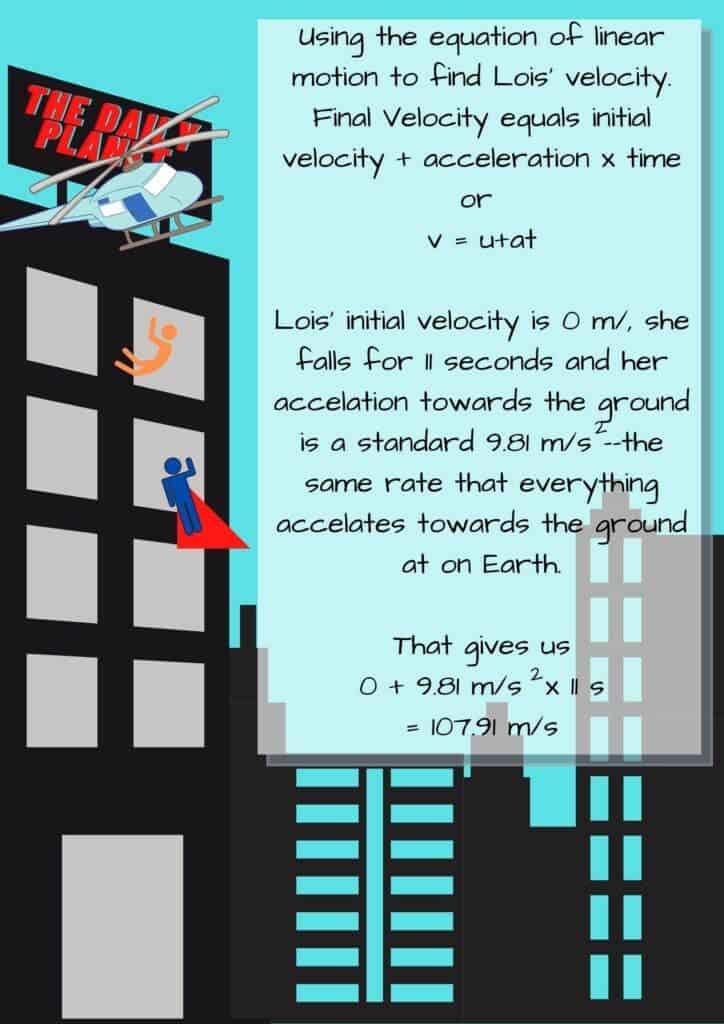
Our calculation means that Lois hits Superman’s arms at about 240 miles per hour! It should be noted that the above calculation doesn’t take into account wind resistance. Fortunately, a team of undergraduates at the University of Leicester calculated just that, estimating that factoring in wind resistance Superman catches Lois travelling at 78.6 m/s — or about — 174 mph!
The team believe that as long as Superman was stationary when he catches the reporter, she would escape with severe bruising. They estimate the pressure she experiences is around 9 x 10⁴ Pa — less than the approximate 1.7 x 10⁵ Pa required to break a small bone.
The truth is, Lois would come to as sudden a stop and experience just as much force if Superman caught her and immediately halted her motion as she would from hitting the pavement.
But, if this daring rescue sets our ‘physics-sense’ tingling, the feat the Man of Steel performs at the conclusion of the same film will be like a fog-horn going off between our ears.
If I Could Turn Back Time
At the climax of Superman (1978) Lex Luthor nukes the San Andreas fault causing massive earthquakes, as part of his plan to raise real estate prices in the area (eh?). Whilst Superman races around saving school buses and acting as a train track in lieu of a downed section of the railroad–let’s not even get into the physics of that stunt– Lois is buried by a landslide, trapped in her car.
The Mand of Steel arrives too late. As he pulls her from her car, he realises the reporter is dead. The movie has already given Clark and the audience a stark reminder that even though he’s Superman — Clark is still a ‘man’. He watches his adoptive father Jonathan die of a heart attack, knowing that even with his considerable powers he is still (mostly) bound by the laws of nature.
Until he isn’t…

Driven by grief, Supes flies into space, whipping around the globe turning it backwards. This would be pretty pointless, but in this case, it happens to also turn back time allowing Superman to rescue Lois, not just from certain death but from literal death.
Even if reversing the rotation of Earth would reverse time — and why would it — surely stopping Earth’s rotation and reversing it should require the exertion of a pretty tremendous force on the planet. Wouldn’t this do way more damage than Lex’s nuke?
Earth is spinning at 1100 mph if it suddenly ‘stops’ its atmosphere would keep going, likely resulting in everything that isn’t very firmly secured to bedrock being flung into space. That’s according to NASA anyway. So Superman had between hope that spinning Earth in the opposite direction reverses time or he’s going to return to a pretty barren planet. Possibly even one with a large crack — or several in it due to the massive force required to halt its rotation.
Maybe, just try and revive Lois with CPR next time Clark.
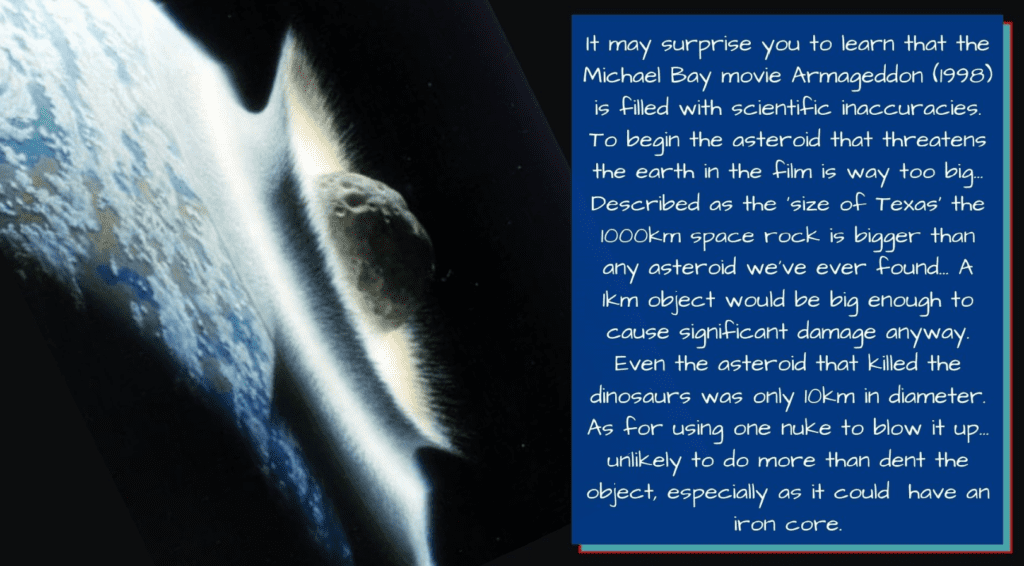
In a Galaxy Far, Far Away… Physics Doesn’t Work…
Look, no one should really expect Star Wars to get physics right. George Lucas’ tale is underpinned by the struggle to control a mysterious universe-spanning magical force — imaginatively titled ‘the Force’ — by what are ostensibly space wizards, thus making it more fantasy than sci-fi. That doesn’t mean we should overlook some real glaring errors though.
In Star Wars: A New Hope (1977), when Luke and Obi-Wan first meet intergalactic rogue Han Solo in the Cantina on Mos Eisely if his roguish nature didn’t put them off a trip in the Millenium Falcon, Solo’s description of the craft as “…the ship that made the Kessel run in less than twelve parsecs…” should definitely have them questioning the smuggler’s technical ability.
Solo is clearly referring to the vessel’s speed as he continues by remarking that the Falcon has also outrun several imperial ships. Problem is, a parsec is, of course, a measure of astronomical distance, not time — equivalent to about 3.0857×10¹⁶ metres or 19 trillion miles!
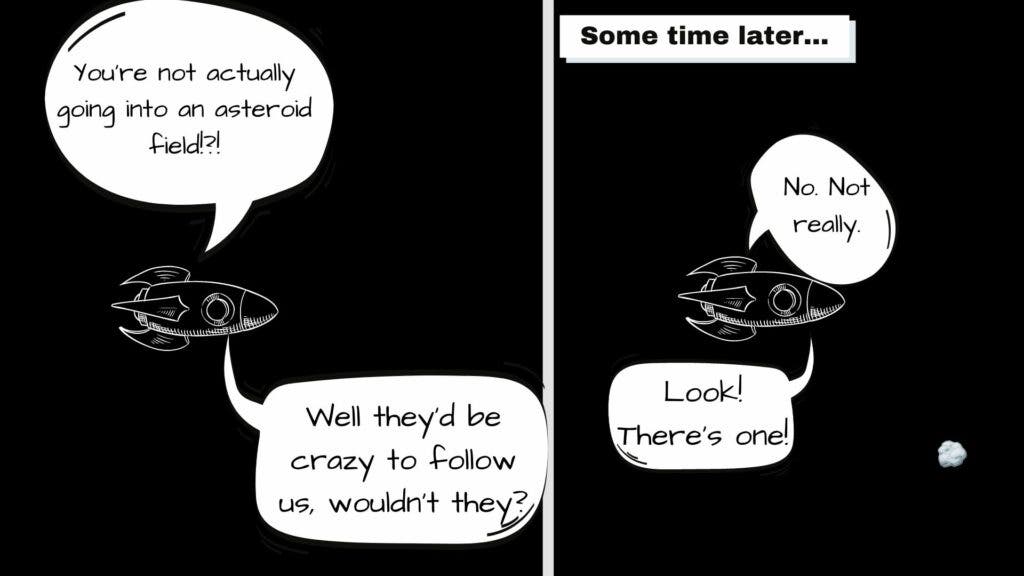
During the film’s sequel, Empire Strikes Back (1980) Chewie will definitely need a toothbrush for his trip aboard the Falcon. The crew travel from the ice world of Hoth to Bespin with a broken hyperdrive, meaning it should be restricted to just below lightspeed. As the canonical distance between the planets is about 5.0 x 10⁴ light-years, the journey should take about 5,000 years!
Distance also plays a problem in the sequel when Han and crew enter an asteroid field. The truth is that entering a real asteroid cluster wouldn’t pose much of a navigational problem to the rebels as the average distance between objects in an asteroid belt is 600,000 miles–or more than 75 times the diameter of Earth!
The Millenium Falcon isn’t the only physics-defying vessel in the Star Wars series. Far from it.
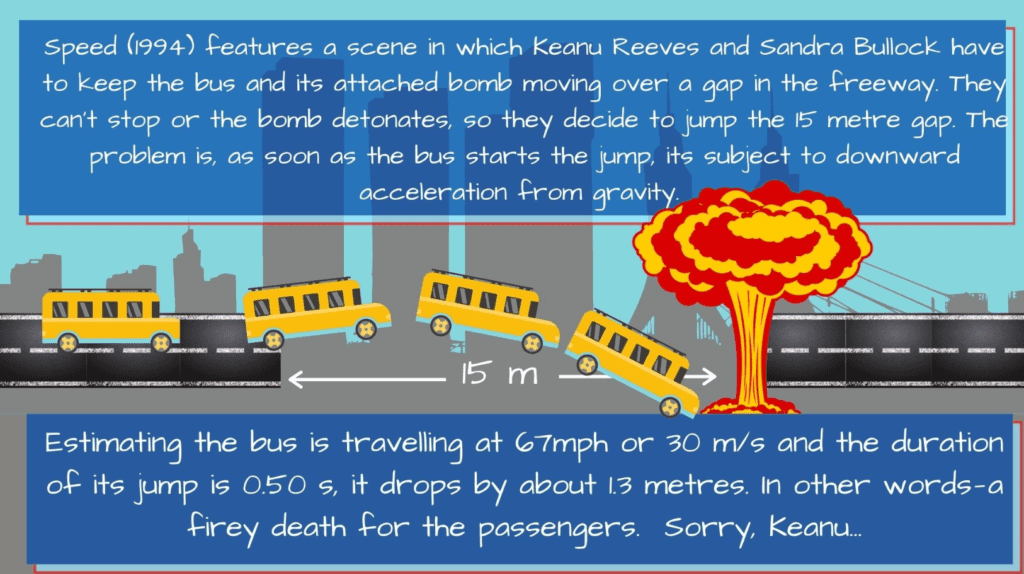
In Space, No-one Can Hear a Physics Nerd Groan
Iconic is probably the only word to describe the ships in Star Wars. The designs of the ships used by both the rebels and the empire are so striking that they changed the idea of crafts in science fiction irreversibly.
What George Lucas envisioned for the franchise was a series of daring dog-fights in space, and arguably this idea is never better realised than at the end of Star Wars as Luke and the rebels race to exploit a tiny chink in the armour of the Death Star (seriously, you couldn’t have put a grate over that?).
The sounds made by the ships are perfect as they dodge and weave during the battle, and who can forget the agonising scream of a strafed R2D2? There’s just one problem…
We shouldn’t hear anything.
In the near-perfect vacuum of space, there is no medium for sound — a mechanical vibration — to propagate through.
One film that gets this right is Stanley Kubrick’ unforgettable 2001: A Space Odyssey (1968). In fact, Kubrick’s masterpiece, based on a story by Arthur C. Clarke gets a lot of its science right. Much of this is due to the fact that Kubrick was aware of NASA’s quest to put a man on the moon — something they would achieve the following year — so didn’t want mankind’s forthcoming giant leap to date his film.
Of course, the sounds of the crafts zipping through space isn’t the only thing that would need to be stripped from Star Wars if that lack of atmosphere in space was factored in. Ships in space couldn’t turn and bank the way craft did during aerial dogfights in the Second World War as they don’t experience air pressure like that banking aircraft on Earth encounter. It’s likely that any attempt to turn would result in endless banking.
The space dogfight described above ends with the titanic explosion of the Death Star.
The problem is, fire needs a fuel to burn and no atmosphere in space means no air and no oxygen to act as fuel for this massive fireball. Of course, we can speculate that there has to be oxygen in the Death Star itself, but nowhere near enough to give us the conflagration we see as the Death Star erupts.
The explosion would be more like a camera flash accompanied by flying debris. Also missing, that amazing ring of flame that perfectly caps off the scene.

At Least Star Trek Gets it Right… Right?
Star Trek, at least the earlier iterations of the show such as the Original Series (1966–1969) and the Next Generation (1987 -1994), is often regarded as the science fiction show that ‘gets it right’ more so than say Star Wars. But, whilst the writers of Star Trek often endeavoured to ground stories with some ‘real science’ and the show has certainly made a mark on the scientists and science communicators of today, the franchise still suffers from some glaring inaccuracies.
The main problem faced by Star Trek is one that is common to any space-faring drama serial or continuing story — the vast scale of space. In order for Kirk, Picard and Janeway to encounter a new alien species almost every week for 24 episodes a year, the showrunners of Star Trek really have to ignore the vastness of space and its relative emptiness.
In the year the first episode of the Original Series, or ToS as the fans call it was aired, the Apollo craft took three days to travel the approximate 375,000 km to the Moon. This is an object that is relatively close to the earth. Meanwhile, on another channel Kirk and Spock are hopping between star systems in a matter of moments. Considering the distance between the solar system and the nearest star system — home of the star Proxima Centauri — is a whopping 4.22 light-years (yes Han, light-years are a measure of distance too) or forty trillion kilometres — you can see the problem the showrunners immediately faced.
Working around these immense distances requires the Enterprise–and most other starships in almost all forms of science fiction– to travel at speeds exceeding that of light. Thus, for such shows to exist and provide a narrative that is more thrilling than forty years of regular duties aboard a starship, they must break this very fundamental limit of physics.
The ‘speed limit of the Universe’ may sound something that is arbitrary, but the idea that nothing with mass can travel faster than light, and the accompanying tenet that accelerating an object of mass to the speed of light would take an infinite amount of force, are crucial to our understanding of modern physics, thus making ‘warp speed’ an impossibility.
Of course, Star Trek fans being an exceptionally clever bunch consisting of mathematicians and physicists of near-genius, have a workaround for this problem. In 1994, the journal Classical and Quantum Gravity published an article by Miguel Alcubierre, a Mexican physicist, entitled ‘The warp drive: hyper-fast travel within general relativity.’
The researcher, also an avid star trek fan, lays out a potential workaround for faster than light travel, explaining that a device that could contract space in front of it, whilst simultaneously contracting space behind it could allow a ship to move at speeds greater than that of light.
Even allowing for this, it still doesn’t quite absolve the problem of the vast distances involved in space travel. Some early episodes of ToS featured the Enterprise crew making trips between galaxies. The average distance between galaxies is 9,900,000 light-years, meaning that even travelling at speeds beyond that of light, such intergalactic jaunts still wouldn’t be feasible in the time scales depicted in the show.
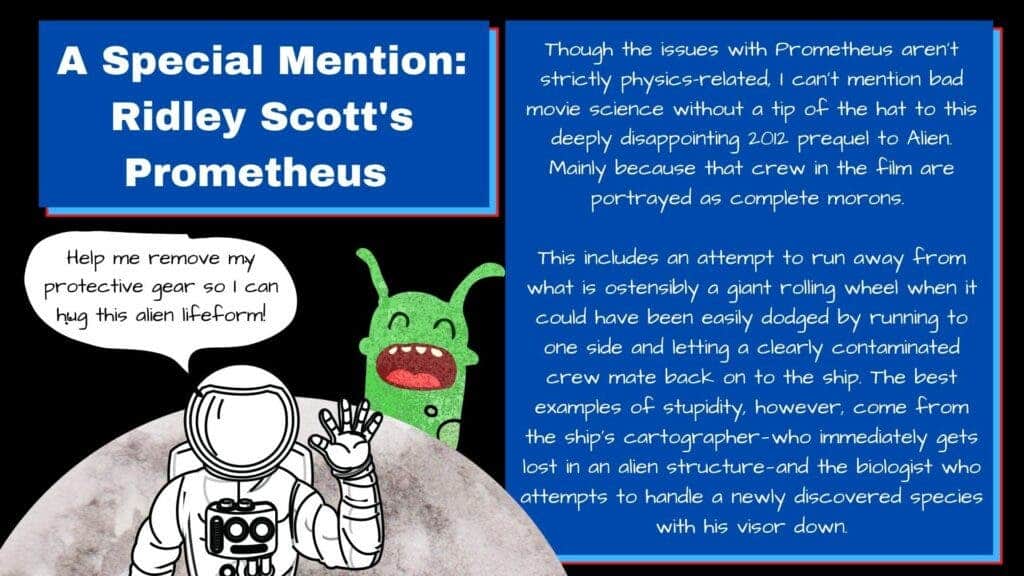
The Beauty of the Suspension of Disbelief
So, should we let these clear violations of the laws of physics bother of us when we are watching a Hollywood movie or TV show?
For me, science fiction and action movies and TV are about escapism. In fact, what bothers me more is when these forms of fiction try to pander too much to science , attempting to pay it very hollow lip service and still get it wrong . I’m looking at you Star Trek: Discovery .
Of course, if you can’t disconnect and accept the technobabble found in shows like Stra Trek there are several alternatives that more closely reflect ‘actual science.’
I’ve already mentioned the pains that Kubrick went to, so that 2001: A Space Odyssey would appear as a somewhat real a depiction of space travel. More recently, Christopher Nolan’s Interstellar (2014) employed theoretical physicist and Nobel laureate Kip Thorne as a consultant to ensure that the physics surrounding the movie’s black hole — Gargantua — reflected current scientific thinking and theories.
The result was a film that was lauded as depicting science fiction’s most accurate portrayal of a black hole. In an interview prior to the film’s release Thorne remarked: “Neither wormholes nor black holes have been depicted in any Hollywood movie in the way that they actually would appear. This is the first time the depiction began with Einstein’s general relativity equations.”
With that said, the above movies aren’t perfect, and why should they be? The occasional violation of the laws of physics in service of a thrilling plot, a breath-taking action scene, or an inspiring feat of heroism is just fine by me.
The truth is, as much as I love science when the opening bars of John Williams’ Superman theme I couldn’t care less about the laws of physics being flaunted on screen.



